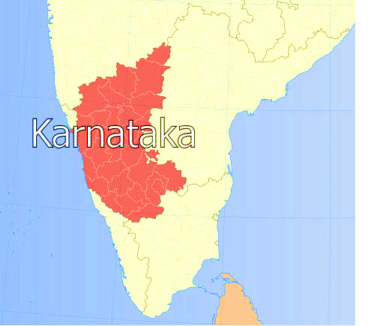
(Bildquelle: PlaneMad/Wikipedia. -- CC-by-sa)

(Bildquelle: PlaneMad/Wikipedia. -- CC-by-sa)
Zitierweise / cite as:
Hodson, Thomas: An elementary grammar of the Kannada, or Canarese language. -- 2. Sandhi, or the Union of Words (§§ 15 - 24). -- Fassung vom 2011-08-23. -- URL: http://www.payer.de/hodson/hodson02.htm
First published as: Hodson, Thomas: An elementary grammar of the Kannada, or Canarese language ; in which every word used in the examples is translated, and the pronunciation is given in English characters. -- 2. ed. -- Bangalore : Wesleyan Mission Press, 1864. -- 128 p. ; 23 cm.
First time published here: 2011-08-23
Revisions:
©opyright: Public domain
This text is part of the section Sanskrit und Indien of Tüpfli's Global Village Library
If you don't get the diacritics displayed, install a Unicode font like Tahoma.
This occasions the elision, insertion, and permutation of letters.
The following observations will save the learner some perplexity in the compounding of words, the declension of nouns, and the conjugation of verbs.
15. When a word ending in ಅ a, ಇ i, ಈ ī, ಉ u, or ಎ e, is followed by an affix commencing with a vowel, euphony requires the following changes ; viz.
16. First. The terminating ಅ a, is cut off. Thus ಕುರುಬ kuruba, and the plural affix ಅರು aru, become ಕುರುಬರು kurubaru, shepherds. See 1st Declension. ಮಾಡುತ್ತ māḍutta and ಏನೆ ēne, become ಮಾಡುತ್ತೇನೆ māḍuttēne, I do. See 1st Conjugation.
17. Second. The terminating ಅ a may either be cut off, or ಯ್ y, may be inserted. Thus ಮಾಡುತ್ತ māḍutta and ಇದ್ದನು iddanu, become ಮಾಡುತ್ತಿದ್ದನು māḍuttiddanu, or ಮಾಡುತ್ತ ಯಿದ್ದನು māḍutta yiddanu, he was doing. See 1st Conjugation.
18. Third. The terminating ಇ i, may either be cut off, or ಯ್ y, may be inserted. Thus ಮಾಡಿ māḍi and ಇದ್ಧಾನೆ iddhāne, become ಮಾಡಿದ್ಧಾನೆ māḍiddhāne, or māḍi yiddhāne ಮಾಡಿ ಯಿದ್ಧಾನೆ, he has done. See 1st Conjugation. ಕುರಿ - kuri, and the affix ಉ u, become ಕುರಿಯು kuriyu, &c. See 3rd Declension.
19. Fourth. The terminating ಈ ī, requires the insertion of ಯ್ y, before a vowel. Thus ಸ್ತ್ರೀ strī, and the termination ಇಂದ iṃda, become ಸ್ತ್ರೀಯಿಂದ strīyiṃda, by a woman. See 3rd Declension.
20. Fifth. The terminating ಉ u, is cut off before many affixes in the conjugation of verbs. Thus ಮಾಡು māḍu, and ಉತ್ತ utta, becomes ಮಾಡುತ್ತ māḍutta, doing. (See 1st Conjugation). ಕೂಸು kūsu, and the accusative termination ಅನ್ನು annu, become ಕೂಸನ್ನು kūsannu, a child. See 4th Declension.
Sometimes ವ್ v, is inserted; as ಗುರು guru, and the accusative termination ಅನ್ನು annu, become ಗುರುವನ್ನು guruvannu, a priest. See 1st example, 4th Declension.
21. Sixth. The terminating ಎ e, generally requires the insertion of ಯ್ y. Thus ಧೊರೆ dhore, and ಇಂದ iṃda, become ಧೊರೆಯಿಂದ - dhoreyiṃda, by a master. See 3rd Declension.
22. When a word ending in any vowel is followed by a word or affix commencing with ಕ ka, or ತ ta, the ಕ ka often becomes ಗ ga; and the ತ ta, becomes ದ da. Thus ಮರ mara, and ಕಾಲು kālu, become ಮರಗಾಲು maragālu, a wooden leg. ಹುಲಿ huli, and ತೊಗಲು togalu, become ಹುರಿದೊಗಲು huridogalu, a tiger's skin.
The letter ದ da, is inserted between ಸಾವಿರ sāvira, a thousand and another numeral. See § 341.
23. When a relative participle ending in ದ da, is compounded with the pronoun ಅದು adu, it, the final ಅ a, of the participle, and the initial ಅ a, of the pronoun are both cut off, thus, ಕೇಳಿದ kēḷida, who or which heard, and ಅದು adu, it, become ಕೇಳಿದ್ದು kēḷiddu, that which (any one) heard. ಕೇಳದ kēḷada, who or which did not hear, and ಅದು adu, become ಕೇಳದ್ದು kēḷaddu, that which (any one) did not hear.
When the past relative participle is irregular, and ends in ಟ್ಟ ṭṭa, the final inherent ಅ a, of the participle, and the initial ಅ a, of the pronoun are both cut off, and the ದ da, of the pronoun is doubled. Thus ಪಟ್ಟ paṭṭa, who or which experienced, and ಅದು adu, become ಪಟ್ಟದ್ದು paṭṭaddu, that which (any one) experienced or suffered.
24. The same rule applies when ಕುರಿತ kurita, the irregular past participle of ಕುರಿ kuri, to aim at, is followed by ಅದು adu. The union becomes ಕುರಿತದ್ದು kuritaddu, that which is aimed at, or concerning that.